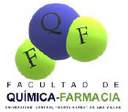
7th International Symposium of Pharmaceutical Sciences
VII SICF
Abstract
Leaves of Croton linearis, known as “rosemary”, are widely used in folk medicine in Caribbean countries to treat fever and colds (associated to infections), that’s why in the present work we accomplish to evaluate the in vitro antimicrobial activity of extracts and fractions derived from C. linearis leaves. Bioassay-guided fractionation and isolation of compounds from an ethanolic extract of C. linearis, using flash chromatography and semi-preparative HPLC-DAD-MS (High Performance Liquid Chromatography – Diode Array Detection – Mass Spectrometry). Isolated compounds were characterized by MS and 1D and 2D NMR (Nuclear Magnetic Resonance) spectroscopy. The microdilution method with resazurin, as well as direct counting in optical microscopes, were used to determine the in vitro antimicrobial activity against bacteria, fungi and parasites. Moreover, the cytotoxicity on three cell lines (human fetal lung fibroblasts (MRC-5), RAW 264.7 (murine macrophages) and Vero cells) was evaluated. The total extract and chloroform fraction (Cl-F) showed high activity against protozoa with IC50 values ranging from 1 to 26 µg/mL. Seven compounds were isolated and characterized for first time in this medicinal plant: the alkaloids laudanidine, laudanosine, reticuline, corydine, glaucine and cularine and the flavonoid glycoside isorhamnetin-3-O-(6''-O-p-trans-coumaroyl)-β-glucopyranoside. Reticuline showed a weak activity against L. infantum (IC50=148.0 ± 1.2 µM), while the flavonoid was active against T. cruzi (IC50=35.6 ± 2.3 µM). This study is a first pharmacological exploration on the leaves of C. linearis. The results show the antiprotozoal potential of the extract and some isolated constituents, which supports the use of this species in Caribbean folk medicine.
Resumen
Leaves of Croton linearis, known as “rosemary”, are widely used in folk medicine in Caribbean countries to treat fever and colds (associated to infections), that’s why in the present work we accomplish to evaluate the in vitro antimicrobial activity of extracts and fractions derived from C. linearis leaves. Bioassay-guided fractionation and isolation of compounds from an ethanolic extract of C. linearis, using flash chromatography and semi-preparative HPLC-DAD-MS (High Performance Liquid Chromatography – Diode Array Detection – Mass Spectrometry). Isolated compounds were characterized by MS and 1D and 2D NMR (Nuclear Magnetic Resonance) spectroscopy. The microdilution method with resazurin, as well as direct counting in optical microscopes, were used to determine the in vitro antimicrobial activity against bacteria, fungi and parasites. Moreover, the cytotoxicity on three cell lines (human fetal lung fibroblasts (MRC-5), RAW 264.7 (murine macrophages) and Vero cells) was evaluated. The total extract and chloroform fraction (Cl-F) showed high activity against protozoa with IC50 values ranging from 1 to 26 µg/mL. Seven compounds were isolated and characterized for first time in this medicinal plant: the alkaloids laudanidine, laudanosine, reticuline, corydine, glaucine and cularine and the flavonoid glycoside isorhamnetin-3-O-(6''-O-p-trans-coumaroyl)-β-glucopyranoside. Reticuline showed a weak activity against L. infantum (IC50=148.0 ± 1.2 µM), while the flavonoid was active against T. cruzi (IC50=35.6 ± 2.3 µM). This study is a first pharmacological exploration on the leaves of C. linearis. The results show the antiprotozoal potential of the extract and some isolated constituents, which supports the use of this species in Caribbean folk medicine.
About The Speaker

Dr. Jesús García Díaz

Profesor de la Universidad de Oriente





